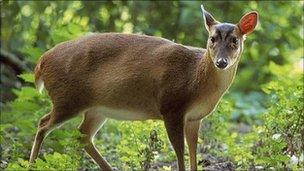Landscape-wide deer management preserves woodlands
- Published

Management initiatives must balance concerns for the deer with concerns for the woodlands they inhabit
Woodlands without effective, wide-scale management systems are more likely to be damaged by the UK's growing deer population, a study has suggested.
Data from 80 Sites of Special Scientific Interest (SSSIs) showed that landowner partnerships over large areas was the best way to deter deer damage.
The impact of overgrazing by deer has a knock-on effect that undermines woodland ecologies, said researchers.
They were reporting at the British Ecological Society's annual meeting, external.
The findings were based on two surveys carried out five years apart, which allowed the team of scientists to identify whether measures to mitigate the impact of the deer were working.
"Monitoring just picks up that there is damage within the sites and offers an indication of impacts," explained Emma Goldberg from Natural England.
"But there was nothing particularly scientific about it, so we decided to carry out the survey… looking specifically at ground flora and browse damage."
Speaking to BBC News ahead of her presentation at the British Ecological Society event at the University of Sheffield, Ms Goldberg explained that the survey offered an insight into whether management strategies such as The Deer Initiative were having any effect.
The Deer Initiative, external is a partnership between a wide range of organisations, from Natural England and Defra to the Association of Chief Police Officers and the RSPCA.
Its goal is to establish a "sustainable and balanced" deer population, while implementing a "humane, responsible and sensitive approach to wild deer management.
"Deer numbers have certainly been rising for the past 40 years, and we believe that they are now higher now than they have ever been," observed Ms Goldberg.
The survey assessed the impact of deer populations on SSSIs in four regions: West Midlands, East Midlands, East of England and the South East.
"We found quite severe impacts in the East of England and the East Midlands, where it seemed that the problem was getting worse over the five years," Ms Goldberg explained.
"Yet in the West Midlands and the South East there had seemed to have been some recovery.
"So it a bit of a mixed story really".
Terrible two
One possible reason, she said, for the worsening situation in the East Midlands and the East of England was a lack of successful management measures being put in place.
Absolute deer numbers in these regions were higher to begin with, but the management systems had not worked as well because there was some difficulty securing an agreement among landowners regarding the best sort of control programme to implement.
Emma Goldberg said it was important to form a partnership over the widest possible area because deer species were mobile and would simply move from one location where management systems were in place to another area where they were not.
She added: "That is why it is important to get an agreement among all landowners on the sort of management techniques to be employed."
There are six species of wild deer in the UK, each having a slightly different impact, but Dr Goldberg said that two species - fallow deer and muntjac deer - were causing the most concern.
Fallow deer are the second-largest species (after red deer) so can graze at about 1.5m off the ground.
"This means that they will browse all of the woody shrub layer out of a woodland," Ms Goldberg explained.
"The ecological knock-on impact is that it can have a direct impact on those shrubs, such as hazel, privet and some of the rarer shrubs, which may get browsed out of the woodland altogether.
"And this has yet another knock-on impact for other species, like dormice or ground-nesting birds.
"Even butterflies can be affected because the shrub layer provides an important nectar source."
She also said that if left unchecked, there were potential lasting consequences from the impact of a growing deer population.
"As well as the shrub layer, the deer will actually eat the regenerating trees, so the long-term forecast of the woodland is unknown.
"If you do not have the regeneration of trees for the future, then that has a long-term impact."